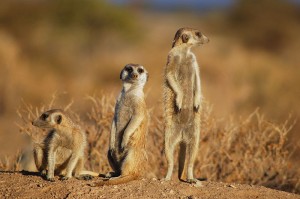‘Míor” + “cat” agus “suri” + “cata” = gleoiteacht! Posted by róislín on Sep 30, 2014 in Irish Language
(le Róislín)

An ‘cait’ iad seo? (grianghraf: http://www.flickr.com/photos/sara_joachim/3166714756/in/photostream ag http://commons.wikimedia.org/wiki/File:Suricates,_Namibia-2.jpg)
I see that my previous cat blog (4 Mí na Nollag 2013) has been reposted (Cats Galore in Irish (Cait, Caitíní, Piscíní, Pisíní, srl.), so I thought this might be a good time to look at another “cat” word, “meerkat,” in Irish. And also to look into where the Latin taxonomical name, Suricata, came from. Some kind of cat, cinnte, but “Suri”?
Aside from providing a possible heyday for young Suri Cruise, one wonders what does “suricata” as such mean. An bhfuil baint ar bith idir “Suri,” ainm iníon Katie Holmes agus Tom Cruise agus an “suri-“ san fhocal “suricata”? Fanaigí go bhfeice muid!
“Suri” as a girl’s name has several explanations, which I’ll give here in Irish, just for beagáinín dúshláin [doo-hlawn]:
1) banphrionsa (Eabhrais); baint leis an ainm “Sarah,” a chiallaíonn “banphrionsa” freisin, is dócha. B’fhéidir gur cuimhin leat gurb í sin an chiall taobh thiar den ainm Sara Crewe sa leabhar A Little Princess le Frances Hodgson Burnett – tá Sara Crewe cosúil le banphrionsa.
2) rós dearg (Peirsis)
Agus cúpla ciall nach raibh i gceist ag Katie agus Tom, is dócha:
peasghadaí (Seapáinis)
coirc (Veinéisis)
géaraithe, ón bhriathar “géaraigh” (Fraincis, foirm den bhriathar “surir”)
And how about “Suricata” and the word “meerkat” as such? I pondered the idea that the “suri” part might be related to the “meer” with the –cata/-kat/-cat part in common, as a suffix, but, no, that would have been way too logical.
Here are some keypoints about meerkats, described mostly in Irish, le haghaidh an dúshláin [le hai un doo-hlaw-in]
- a) Ní cait iad na míorchait. Tá siad “ *catchruthach ” [KAHT-KHRUH-hukh] ach ní cait iad. For “catchruthach,” which I don’t think you’ll find in any dictionary (at least I can’t), please see note 1 below.
- b) Gaelú ar “meer” é “míor-.” Ní gnáthfhocal i nGaeilge é “míor” (breis eolais uait? féach nóta 2 thíos) ach tagann “meer” ón fhocal Ollainnise “meer” (“loch,” cosúil leis an “-mere” i Windermere, srl.)
- c) Níl baint ag míorchait le locha cé go gciallaíonn “meer” “loch.” (Natch!)
- d) Ní thugann na hÍsiltírigh “meerkat” ar na míorchait ach “stokstaartje” (“batarubaillín,” mar dhea). An féidir leis an scéal seo a bheith níos casta?
- e) Is í “an tSiria” an chiall atá ag an chuid “suri” den ainm Laidine “suricata.” Ach cén fáth “an tSiria” má bhíonn cónaí ar na míorchait in iardheisceart na hAfraice? Níl freagra na ceiste sin agamsa!
Next, since we’ve explored cúlra and gaelú for the word ‘míorchat,” let’s look at its different forms. The good news is that it works pretty much like the word “cat” itself, first declension, masculine:
an míorchat, the meerkat,
an mhíorchait, of the meerkat; mainéar an mhíorchait (the manor of the meerkat)
na míorchait, the meerkats
na míorchat, of the meerkats; mainéar na míorchat (the manor of the meerkats; nasc don chlár teilifíse Meerkat Manor thíos)
Apparently the meerkat young can be called “meerkittens,” even though “meerkats” aren’t cats. It seems too cute to be true, but there are 63,800 hits for “meerkitten” in my preliminary Google search for it. So should the Irish be “míorphiscín,” based on “piscín,” the usual Irish word for “kitten”? Or “míorphisín,” since “pisín” is a variation of “piscín”? Or “míorchaitín,” which could also mean “small meerkat”?
Other sources I looked at for this blog say that the young of the meerkats are called “cubs,” so that would be “coileáin.” “Coileán” also means “puppy,” and is typically used for the young of dogs and foxes.
So that seems to bring us to a full circle … of some sort. “Meerkats” aren’t cats but the English apparently borrowed name for them from a Dutch word that seems like “cat.” But the Dutch (Nederlands) word for them actually means “little stick-tail.” The Latin taxonomical name, Suricata, introduces a connection to Syria, which doesn’t seem geographically plausible. And while some people refer to “meerkittens,” the more technical term for their young seems to be “cub.” None of the variations of “míorphiscín” that I could think of yielded any results in Google searching (leniting, substituting “pisín” and “caitín” for “piscín,” etc.)
C’est la vie! Suimiúil, ar a laghad. And whatever the history of the word itself, the meerkats certainly give cats and kitten a run for their money as far as cuteness (gleoiteacht) goes. Next up, b’fhéidir, “ *faoileoirí siúcra”? Cé acu is gleoite? A Vicki? ‘S ise an t-aon duine amháin a bhfuil aithne agam uirthi a bhfuil faoileoirí siúcra mar pheataí aici! SGF — Róislín
Nóta 1: I patterned the word “ *catchruthach “ on words like “snáthchruthach” (filiform) and “ubhchruthach” (egg-shaped). It means “feliform,” which can be an adjective or a noun.
Nóta 2: Is fo-leagan den fhocal “mír´(piece) é “míor” ach ní hé an gnáthlitriú é. Ní bhaintear mórán úsáide as, i mo thaithí féin.
Nasc don chlár teilifse Meerkat Manor: http://www.meerkatmanor.co.uk/

Build vocabulary, practice pronunciation, and more with Transparent Language Online. Available anytime, anywhere, on any device.




Leave a comment: